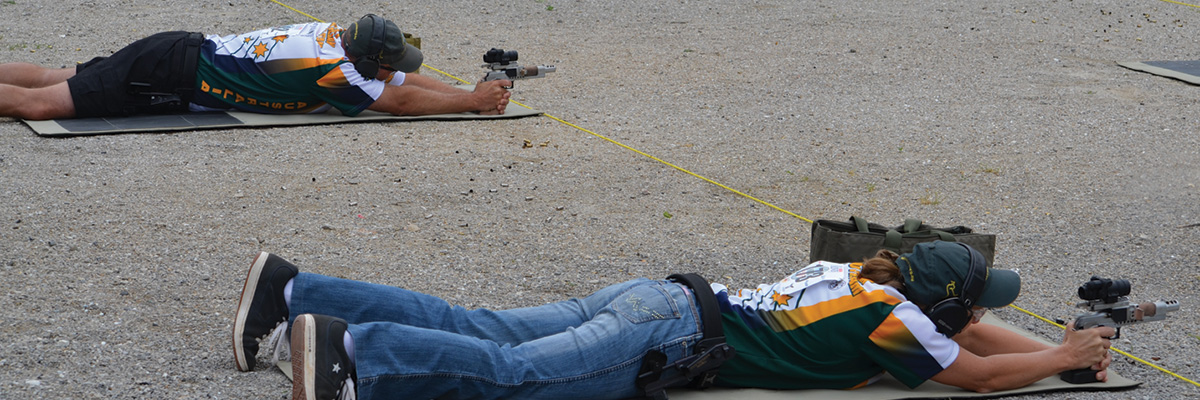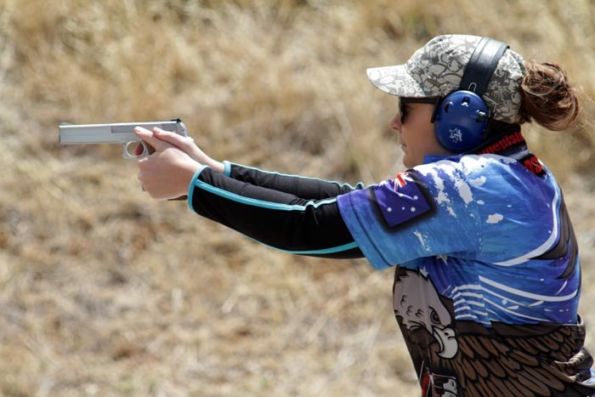Action Match
Action Match is a fast paced pistol discipline requiring the use of self-loading pistols or revolvers to shoot at various targets. It includes four firearms classes (Open, Open Modified, Metallic Sight and Production) and consists of four competition ‘stages’ or events. (Practical, Barricade, Moving Target, and Falling Plate)
Steel Challenge became part of the Action Match discipline in 2009.
A brief description
John Bianchi, a former US police officer and CEO of holster manufacturing company Bianchi International, developed Action Pistol shooting in 1979. In 1985, control of the discipline was transferred to the National Rifle Association (NRA) of America. Action Pistol was later introduced to Australia as Action Match by special agreement with the SSAA. Action Match is a demanding handgun competition, but beginners should not be daunted, as the discipline is graded to accommodate a range of abilities. However, like other disciplines, to be top of the game, particularly internationally, a commitment to regular and dedicated practice is required.

Categories
The handguns used in Action Match fall into several categories, including Open, Open Modified, Production and Metallic Sight.
Open
Open rules and restrictions on the type of handgun (pistol or revolver) and accessories used are very liberal, provided the handgun is safe. Pistols can be fitted with metal ‘wings’ to help support them when shooting around a barricade. Peep, ghost, optical or electronic sights may be used, as can ported and compensated barrels.
Open Modified
Open Modified does not allow for metal ‘wings’ and is a category suitable for IPSC open handguns.
Production
Production consists of readily available, commercially produced pistols fitted with metallic sights. Again, the handgun can be a self-loader or revolver. All standard safety features of the handgun must operate properly and custom shop pistols are not allowed. There are some minor modifications that have been approved, which have little effect on the overall competitiveness of the handgun.
The cost of a handgun is a major consideration when getting into Action Match. Most clubs have handguns for a beginner shooter to try. With a Production category handgun, anyone can get involved at minimal cost and be quite competitive with an over the counter pistol or revolver. Many manufacturers produce handguns suited to the Production category.
Metallic Sight
Metallic permits the use of metallic sights. There are maximum barrel and sight radius dimensions in this category, as well as a minimum calibre restriction of 9mm.
Course of fire
Although NRA rules provide for more than a dozen events, only four events are shot in Australia, with each event consisting of a total of 48 shots. These follow the courses of fire used in the Bianchi Cup tournament. The match requires 192 rounds and is scored out of 1920 points. On the paper-target events, a small ‘X’ inside the ‘A’ scoring zone is used for tie-breaking. A hit in the ‘X’ zone is scored as 10.1. The match is shot in ‘strings’ of six shots at various distances and different time limits. Some events must be shot standing and others may be shot from the prone position. Generally, as the distance increases, the time allowed also increases. The four courses of fire are Practical, Barricade, Moving Target and Falling Plate.
Practical
Competitors must fire the 10-yard segment in the standing position. Other distances may be from the prone position at their option. The shooter draws and fires one shot at each target in three seconds, followed by two shots at each target in five seconds, followed by three shots at each target in six seconds. A similar pattern is followed at 15, 25 and 50 yards, with slight timing changes.
Barricade
Targets are engaged from standing behind a barricade. All competitors may use the barricade for support. However, no part of the handgun can rest against the barricade, except for Open category pistols. Six shots are fired from 10, 15, 25 and 35 yards twice. Times vary with distance from five to eight seconds, depending on the distance.
Moving Target
The target travels across a distance of 60ft in six seconds. Six shots are fired from 10 and 15 yards twice. Three shots are fired from 20 and 25 yards four times. All competitors shoot from the standing position.
Falling Plate
Six shots are fired from 10, 15, 20 and 25 yards, with times varying from six to nine seconds depending on distance. The competitor must shoot the 10-yard stage from the standing position. The 15-, 20- and 25-yard stages may be shot in the prone position at their option. The targets are 8" steel plates, which must fall for a score to be registered.
Equipment
The categories described on the right each allows for different equipment and accessories. Competitors normally specialise in one category rather than attempt all three. As the stages consist of six shots or a multiple thereof, revolvers are very competitive in Action Match. In Australia, the most popular cartridges are .38 Super, .357 SIG, 9x19mm (9mm Luger) and .38-45 for self-loading pistols and .38 Special and .357 Magnum for revolvers. Ammunition has to make ‘power factor’ of 120,000 to be allowed for competition. Power factor is calculated by multiplying the bullet weight (in grains) by muzzle velocity (in feet per second) as measured by a chronograph. Pistols are drawn from a holster and shooters must be accredited to use a holster to shoot competitively.



